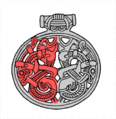Jelling style
The Jelling style (also: Older Jelling style) is a Viking Age art style in Scandinavia. Its distribution period extends from the beginning of the 10th century to around 975. It is named after its key find from the royal tomb of Jelling in Denmark. It appears on wooden, metal and stone utensils, jewelry and rune crosses from this period.
Emergence
Through the intensified contact of the Scandinavians with the Anglo-Saxon world in the course of the Viking Age, the knowledge of the motifs of illuminators, stone masons and fine smiths from the British Isles increasingly came to Scandinavia. Narrow, elongated animal figures, such as those used on Anglo-Saxon art products, found their way into Viking Age art. The narrow animal figures replaced the predatory animal that had prevailed in the previous Viking Age art styles as the most important motif.
characterization
The art styles of the Viking Age are ornamental styles and are composed of three subject areas:
- Figures, i.e. people and depictions of animals
- Depictions of plants (tendrils, leaves)
- geometric figures (circles, triangles, triskeles , spirals ).
The Jelling style focuses primarily on animal figures, which are shown particularly narrow and elongated. The band-shaped, equally wide figures usually wind themselves in an S-shape and are always shown in profile. While the windings appear more curled up in the eastern Scandinavian area, they are more stretched in the western area. The body of the animals is decorated with a kind of ladder pattern or pearl-like. Compared to the squat figure representations of the previous styles (Oseberg style, Borre style), these figures represent a novelty. Another characteristic of the Jelling-Sil are the leg spirals: The beginnings of the animal legs are rolled up spirally starting from the thigh. Neck scoops are also characteristic: from the neck of the animal, more or less long and twisted braids go off. In addition, the head of the animal is shown with its mouth open and a bulge on the upper lip typical of the Jelling style. This bulge is also sometimes interpreted as a nostril. The thinner, tendril-like decorations such as the neck crest or smaller secondary figures are provided with a central band along their entire length. The Jelling style was particularly popular in Great Britain and the Isle of Man, where several rune crosses are designed in this style.
Jelling style ribbon-shaped animals. The three asymmetrically distributed curls on the top of the animal's neck are reminiscent of the shape of the left wing of the mammal bird . Silver clasp, found in Skaill, Orkneys, UK.
Sample finds
- Denmark
- Silver goblet from the royal tomb in Jelling, Danmarks Nationalmuseum, Copenhagen
- Collar fittings by Mammen, gold-plated copper alloy with nielloed silver sheet inlays, Jutland, Danmarks Nationalmuseum, Copenhagen
- Horse yoke from Søllested, Lolland,
- Norway
- Oval brooch made of bronze by Morberg, Buskerud, Universitetets Oldsaksamling, Oslo
- Circular primer, Tråen, Buskerud,
- Sweden
- Silver fibula from Ödeshög, Östergötland,
- Tongue-shaped brooch made of bronze, Birka, Uppland,
- Pendant from the Vårby treasure, gold-plated silver, Vårby, Södermanland, Statens Historisk Museum, Stockholm
- other countries
- Bronze pendant from the treasure of Gnesdowo , Smolensk, Russia, Gosudarstvennyj Ermitaž, St. Petersburg
- Schwertortband, copper alloy, Coppergate, York, UK, The Yorkshire Museum
- Bronze sword hinge, Astala, Satakunta, Finland, Finland's National Museum
literature
- Reinhard Barth: Pocket dictionary Vikings . Piper, Munich Zurich 2002, ISBN 3-492-23420-8 (short description)
- Ewert Cagner: The Vikings . 3. Edition. Burkhard-Verlag Ernst Heyer, Essen 1992, ISBN 3-87117-000-3 (with several detailed sample drawings and many large-format color photos)
- Torsten Capelle: Cultural and Art History of the Vikings . Scientific Book Society Darmstadt, Darmstadt 1986, ISBN 3-534-02509-1
- Hildegard Elsner: Viking Museum Haithabu: Showcase of an early city . 2nd Edition. Karl Wachholtz Verlag, Neumünster 1994 (overview of individual styles with sample drawings)
- James Graham-Campbell: The Lives of the Vikings . Universitas Verlag in FA Herbig Verlagsbuchhandlung GmbH, Munich 1993, ISBN 3-8004-1297-7 (popular science, detailed presentation and photos)
- Michael Müller-Wille and Lars Olof Larsson: Animals - People - Gods. Viking age art styles and their modern reception . Vandenhoeck & Ruprecht, Göttingen 2001, ISBN 3-525-86309-8 (for the chronological classification of wooden finds and the duration of individual art styles)
- Arnold Muhl and Rainer-Maria Weiss: Vikings, Varangians and Normans: the Scandinavians and Europe 800 to 1200 . Staatliche Museen, Preussischer Kulturbesitz, Berlin 1992, ISBN 3-88609-304-2 (exhibition catalog with text contributions and pictures in the extensive catalog section)
See also
Individual evidence
- ↑ Capelle: Art History . Page 113.
- ^ David M. Wilson: The earliest animal styles of the Viking Age . In: Michael Müller-Wille and Lars Olof Larsson: Animals - People - Gods. Viking age art styles and their modern reception . Vandenhoeck & Ruprecht, Göttingen 2001, page 151.
- ↑ a b Capelle: Art History , page 114.
- ^ Graham-Campbell: Vikings . Page 142.
- ↑ Meehan: Celtic Design . Page 57.
- ↑ Meehan: Celtic Design . Page 58.
- ↑ a b after Smith: Viking Design , page 18.
Web links
- Danmarks Nationalmuseum, Copenhagen (German)
- Website of the Kulturhistorisk museum, Oslo (Norwegian)
- Website of the Statens Historisk Museum, Stockholm (English)
- Viking Museum Haithabu, Schleswig (German)
|
Previous art style Borre style |
Jelling style early 10th century - around 975 |
Following Art Style Moms Style |




